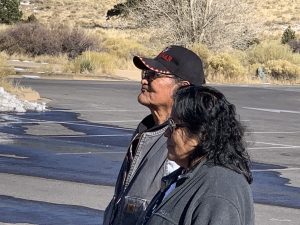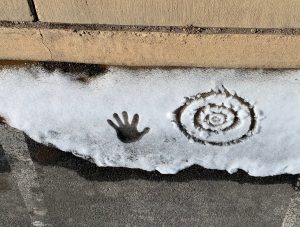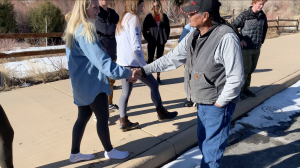The Great Sand Dunes roll like waves without crests. Seven hundred feet tall, towering before me, their flawlessly smooth surface seemed impossible.
Our class of twelve young journalists drove from our temporary home in Crestone, Colorado to Alamosa, hoping to clear our minds amidst the dunes after days of intensive interviewing and article writing. I swung the car door open excitedly as soon as we arrived, pulling my shoes off without the patience to untie them, and threw them into the car. Barefoot, I skipped playfully toward the entrance of the Great Sand Dunes National Park.
But just then, our plans were slightly delayed — and for the better. We were arriving just as Bryan Vigil and Lorene Willis were leaving, accompanied by Park Ranger Fred Bunch.

Bryan Vigil and Lorene Willis. Photo by Bruce Finley.
Vigil and Willis are Jicarilla Apache Indians. The tribe’s native lands are the Sangre De Cristo Mountains, whose jagged peaks and textured slopes serve as a juxtaposing backdrop to the dunes.
Vigil, a 68-year-old elder, spoke to us about coming to the dunes in his younger years to train horses and strengthen his legs by running in the sand. The land of Southern Colorado holds deep significance to the Apache people — but unfortunately, it has not always looked the way it does today.
“Grandma says we’re gonna see four trees dried up,” explained Vigil, staring nostalgically at the mountains. He counted on his fingers as he listed them. First was the Piñon, roughly fifteen years ago. Next they saw the Aspens fade, and now spruce are disappearing, explained Vigil.
Grandma told him,
“When the White Cedars dry up as far as you can see, you’re gonna carry your belongings on your back.” He held up his fourth, smallest finger.
These disappearances are a result of many factors, notably Southern Colorado’s shift to aridity due to changing climate and rising temperatures, as well as land development.
As we humans find ourselves less and less connected to nature as a result of a constructed landscapes and technologies, the Apache say,
“Go back. Learn the plants, medicine plants, edible plants. Learn how to camp. But first they tell you, learn how to make fire again,” Brian said. This is to maintain a personal connection to the land, to remember where they came from and not be dependent on unreliable advancements of the modern day.
The Apache have also felt the impact of dwindling resources in regards to water.
“They told us back then that water was gonna be precious, they would bring it in bottles and you’d pay a lot of money for it. In the 1970’s, water was just so abundant you know, you could drink it from the spring and it was just everywhere,” Willis said, reminiscing on younger years when she listened to the prophecies of elders.
“It just seemed so ridiculous to think that water would be so precious that you had to pay for it,” she added.
Though the Apaches have experienced negative effects of a changing climate firsthand, they are not hopeless. The Apache elders who prophesied these changes also assured them that,
“That’s one path. That’s one way it could happen. It doesn’t have to be that way, all the doom and gloom,” according to Willis.
To the Apache, the most important step in saving our planet is human connection. They talk about different groups of people as hoops, and peace on earth being the product of each of these hoops eventually joining together.
“In order for us to get there we have to start respecting each other, recognizing that we’re all human beings on this planet and it’s up to us, were gonna have to save our planet,” explained Willis.
“That day when we make peace with all the people, even that grass is gonna push itself up from the earth so that it could be a part of that day.”
While Willis was speaking, Vigil stepped towards a small sheet of snow pressed against the curb of the sidewalk. He bent over and gently pressed his hand into the snow with spread fingers. He pulled away to reveal a shallow handprint.

Bryan Vigil’s handprint in the snow. Photo by Bruce Finley.
Vigil told of a time he trekked near the Pinon Canyon Maneuver Site around fifteen years ago. He travelled with an elder and the elder’s young grandson, who he carried along piggy-back style.
As they hiked, “there came some art drawings or artifacts or whatever you’d call them, drawings on the wall. There was a handprint like that—” Vigil bent over and pointed down at the marking he had just made with his hand.
When the elder asked if Vigil knew what the handprint was, Brian had simply replied that it was a hand somebody had carved. But the elder told him he was wrong.
“One of these days in the future, all the people on this planet with five fingers are gonna come together to save this place, this planet,” the elder had told Vigil. The Apache believe that no matter the differences between individual humans, this planet is the one thing we all share — and so, our responsibility to care for it is shared too.
And the first step to caring for it, is connecting to it.
“We were told to stay in contact with everything, with the earth. Thats why were told, pray barefooted, or wear moccasins,” Vigil said. He noticed my shoeless feet on the cold concrete, pointed to them, and smiled.
This connection to the land reflects the Apaches responsible treatment of nature and its resources, according to Park Ranger Bunch, who works closely with the Apache. He makes great efforts to honor and learn from Native customs and beliefs.
There is a stand of Ponderosa Pine trees nearby in the valley that have been stripped of huge sections of their bark on one side, and rangers were baffled as to what could’ve caused this.
“No one had ever seen a six foot tall porcupine,” joked Bunch.
They later learned that native tribes had removed the bark to use for food, medicine, and fire starters, utilizing the resources without killing the tree.
“They say a mosquito would starve on what native people wasted,” Bunch said.
As trees disappear despite our desperate need for carbon sequestration in our heavily polluted atmosphere, the ancient Apache method seems ahead of its time. Their efforts to conserve nature were intuitive, not reactionary.
As we said goodbye, Bryan shook my hand. His palms were rough and tired, but his grip was firm.

Journalist Johnna Geick shakes hands with Jicarilla Apache Elder Bryan Vigil. Photo by Bruce Finley.
“You were listening with both your ears. I noticed,” Bryan said to me, our hands still locked. He complimented the beads around my neck and nodded goodbye.
As our class finally entered the park, I felt as though Bryan had left something in my hand, some imperceptible seed of responsibility.
Suddenly I was somewhere far away, walking not on sands but rather thousands of years of history. My calves burned and my lungs protested as I quickly ascended the dunes before me, but something internal and removed from the physical drove me to continue.
I needed to see every inch of these lands. With every crest I reached on each dune, another dune manifested itself. I could’ve wandered their expanse for a lifetime.
Eventually, I gave in to my physical exhaustion. Mid way up a steep, sandy slope I paused on my hands and knees to catch my breath. With clenched fists I clutched sand desperately, hoping not to slide down and lose any of the valuable progress I’d made. Face down and heaving, I stared intently at the surface beneath me.
At once, I saw every individual grain of sand for the independently existing object that it was. Each a different color, whether blue, grey or beige, glasslike or matte and opaque. Some incomprehensible number of minuscule grains of sand comprised the entire stretching expanse of massive dunes. I was mesmerized, and stared intently as some of these particles slipped down the dune under the weight of my body.
Every thing, every place, this world, is composed of so many tiny but invaluable working parts that are easy to overlook when we are focused only on the bigger picture. Each one of us is a tiny, invaluable working part.
“Parks, monuments, are manifestations of political system. They can be deregulated, they can be moved, they can be changed,” Bunch had said.
“But if people believe in them, and this land is protected and set aside and there’s no extraction or consumption, for the purposes of enjoyment of the people, then that’ll continue.”
As I digested these words with mountains to my left, open plains to my right, and dunes beneath my feet, imagining any of it lost to development or resource extraction seemed criminal.
As we see our climate change for the worse, the Apache say it takes a return to the natural world, a renewed appreciation for the Earth as our home and supplier of sustenance, to spark a desire to save it.
I was left with Bunch’s last words to us echoing in my head: “The key thing for you is to adopt that legacy, pass it on. Our greatest natural resource is the minds of our young people. And that’s you.”
